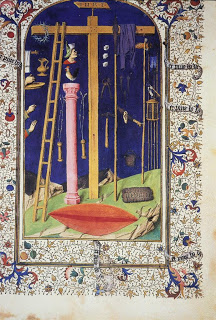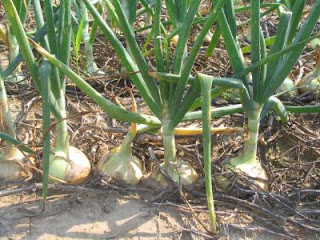Medieval History
 We've had a new student join our Ecology of Medieval Art class, and it was to him that I turned first in asking for a description of the image on the screen (the same one that you see here). "An arrangement of minerals, stones, and quartz," he said. Absolutely, yes, thank you. I then asked a student who'd been here the first day, and she answered, "It's a picture of our class." Oh how this course gives!!! On the first day of class, I'd positioned the twenty objects you see, one at each spot at the seminar table. Students sat, some in accordance with the rock they wanted, others, to immediately start trading stones. I asked them to read Lowell Duckert's marvelous essay in Animal, Mineral, Vegetable: Ethics and Objects (edited by Jeffrey J. Cohen and out through Oliphaunt Books last year): "Speaking Stones, John Muir and a Slower (Non)Humanities," and to write about where they would be placing their stone for the duration of the semester. Some carry their stones with them, others have put them within sight, out of sight, framed, ensconced, placed to be picked up again and again. And all, judging by the smiles today when the student answered "It's a picture of our class," have elided subjectively with their stones. I thought that they would still say that those were their stones, or the stones given to them, or something else that still made the stones a separate object for their use. Perhaps this is the rapid work of Jane Bennett's Vibrant Matter (chapter one was due to be read today), or the Anglo-Saxon riddles I asked them to read in combination with Bennett, but in that answer, those students were ready to talk about thing-power, and its ability to trouble the boundary between the human and the non-human (and I know that she was being metonymic, not necessarily loosening her sense of self when she answered - but metonymy can do powerful work to trouble boundaries).
We've had a new student join our Ecology of Medieval Art class, and it was to him that I turned first in asking for a description of the image on the screen (the same one that you see here). "An arrangement of minerals, stones, and quartz," he said. Absolutely, yes, thank you. I then asked a student who'd been here the first day, and she answered, "It's a picture of our class." Oh how this course gives!!! On the first day of class, I'd positioned the twenty objects you see, one at each spot at the seminar table. Students sat, some in accordance with the rock they wanted, others, to immediately start trading stones. I asked them to read Lowell Duckert's marvelous essay in Animal, Mineral, Vegetable: Ethics and Objects (edited by Jeffrey J. Cohen and out through Oliphaunt Books last year): "Speaking Stones, John Muir and a Slower (Non)Humanities," and to write about where they would be placing their stone for the duration of the semester. Some carry their stones with them, others have put them within sight, out of sight, framed, ensconced, placed to be picked up again and again. And all, judging by the smiles today when the student answered "It's a picture of our class," have elided subjectively with their stones. I thought that they would still say that those were their stones, or the stones given to them, or something else that still made the stones a separate object for their use. Perhaps this is the rapid work of Jane Bennett's Vibrant Matter (chapter one was due to be read today), or the Anglo-Saxon riddles I asked them to read in combination with Bennett, but in that answer, those students were ready to talk about thing-power, and its ability to trouble the boundary between the human and the non-human (and I know that she was being metonymic, not necessarily loosening her sense of self when she answered - but metonymy can do powerful work to trouble boundaries).
I love those rocks. I chose them carefully at Squire Boone Caverns in southern Indiana this summer, thinking of the students I'd be working with, learning about each stone over the intervening months. Satin spar, citrine, lodestone, fossilized whale bone, agate nodule. Don't they have great names? The goal was to move, with Jane Bennett, from thing-power via Spinoza's conatus to LaTour's actants and the idea of assemblage by way of Bogost's Latour Litanizer and in the process to continue to articulate our interest in the ontology of the non-human. Loving the idea of "assemblage as a perceptual style that is open to the appearance of thing-power" (5), I showed them this...
... and asked them to simply call out the names of the objects that they saw. Ladder, ear, column, dice, nails, spit, lance, rooster. I find the Arma Christi such a fantastically haunting image: all objects, no human. (When it's the Mass of Saint Gregory, there's lots of Christ, but here, no, just some impossible space and time of representation). What is the Crown of Thorns when it is not on Christ's head? Is its thorniness more manifest? Are the nails' nailness more apparent? And then the medieval twist to this assemblage: the large swath of red at the bottom of the image that students started asking about, having identified all of the other objects: it's the wound of Christ (I actually got a gasp from one of the students on that one...!). What is the Wound of Christ when it is an object? Does it reveal its woundness to a greater degree? Does it recede further? I steered some students away from narrative and iconography - away from anything resembling epistemology - and insisted on a preoccupation with ontology. The being of these objects are all ultimately predicated on the Crucifixion, but that's later. Here, now, always, they are objects unto themselves, resisting our urge to subsume them into narrative, and possibly even morality. Does that mean that they mean nothing? Yes, in that that is not our concern, but just think: they are completely (well, as completely as an object in/as an image can be - something I need to work on: the ontology of representation).
And then the Riddles, the glorious Riddles, which allowed us to talk about the resistance of objects: riddles resist. (Some dare you to figure out what they are). Two big realizations emerged from this session: that there is a communal re-cognition of things, and that nature has a volatile ontology. I had the students again litanize: they read their answers to the five selected riddles and I filled them in on a table so that in a matter of minutes we had 100 words assembled in a Word document table. That in and of itself became a representation field - and a fertile one at that. For #31 (commonly identified as iceberg), we had both snail and shark. One student said "ocean rocks" which is a great way to describe an iceberg. #79 (commonly identified as gold) produced more "trees" than "gold." And my favorite, #23 - because it is commonly identified as an onion or a phallus, but in our class was over and over again dubbed a thorned rose. The class shifted from being an assembly of individuated thinkers to an assemblage of desires that produced roses, where others had wanted onions and phalluses. We now will, in our class, add roses to the litany of answers we could provide to this riddle. Here is said riddle, whose object now hovers in representation, no definite thing, but definitely a thing.
- Objects That Orient Ontology
Petrus Christus, Carthusian MonkWe've been spending the semester in my medieval art history class thinking about "Painting and Presence." Petrus's Carthusian Monk was my avatar on Facebook, I found him at the Met - we're in deep. Though...
- Fragmentation, Loss, Utopia
Arma Christi, c.1300Prester John is only visualized when he is racialized. I've only seen images of him once he is Ethiopian, later in his career within the Western imaginary. His early days in India, chronicled in the letter from him...
- Everything And More
Annunciation, 1400s.The meeting with Jim the geologist and Dan the chemist was terrific. This vivid (look at the breath of God!) alabaster Annunciation from the Philadelphia Museum of Art will help here. What is this profound thrill of newly gained knowledge?...
- Fragments
Arma Christ. Musée Jacquemart-André, ParisIn the 10 minutes before I need to start gathering the kids from their play dates, I think that I can put into words why writing has eluded me of late. I've wanted to everyday, but the balance of navel gazing...
- Ex-voto
Ex-VotosIt's amazing what happens when intellectually generous people get together. I always held that medieval mattered - thus, well, my entire life, but here, there's a pertinent place for that insistent sometimes even urgent belief. ...
Medieval History
Thing-Power in the Classroom: stones, ladders, spit, onions, phalluses and roses
I love those rocks. I chose them carefully at Squire Boone Caverns in southern Indiana this summer, thinking of the students I'd be working with, learning about each stone over the intervening months. Satin spar, citrine, lodestone, fossilized whale bone, agate nodule. Don't they have great names? The goal was to move, with Jane Bennett, from thing-power via Spinoza's conatus to LaTour's actants and the idea of assemblage by way of Bogost's Latour Litanizer and in the process to continue to articulate our interest in the ontology of the non-human. Loving the idea of "assemblage as a perceptual style that is open to the appearance of thing-power" (5), I showed them this...
 |
| Arma Christi, 15th c. Boucicaut Master |
 |
| The Onion one |
I am a wonderful help to women,
The hope of something to come. I harm
No citizen except my slayer.
Rooted, I stand on a high bed.
I am shaggy below. Sometimes the beautiful
Peasant's daughter, an eager-armed,
Proud woman grabs my body,
Rushes my red skin, holds me hard,
Claims my head. The curly-haired
Woman who catches me fast will feel
Our meeting. Her eye will be wet.
--- trans. Craig Williamson, A Feast of Creatures (University of Pennsylvania Press, 2011)
- Objects That Orient Ontology
Petrus Christus, Carthusian MonkWe've been spending the semester in my medieval art history class thinking about "Painting and Presence." Petrus's Carthusian Monk was my avatar on Facebook, I found him at the Met - we're in deep. Though...
- Fragmentation, Loss, Utopia
Arma Christi, c.1300Prester John is only visualized when he is racialized. I've only seen images of him once he is Ethiopian, later in his career within the Western imaginary. His early days in India, chronicled in the letter from him...
- Everything And More
Annunciation, 1400s.The meeting with Jim the geologist and Dan the chemist was terrific. This vivid (look at the breath of God!) alabaster Annunciation from the Philadelphia Museum of Art will help here. What is this profound thrill of newly gained knowledge?...
- Fragments
Arma Christ. Musée Jacquemart-André, ParisIn the 10 minutes before I need to start gathering the kids from their play dates, I think that I can put into words why writing has eluded me of late. I've wanted to everyday, but the balance of navel gazing...
- Ex-voto
Ex-VotosIt's amazing what happens when intellectually generous people get together. I always held that medieval mattered - thus, well, my entire life, but here, there's a pertinent place for that insistent sometimes even urgent belief. ...
